Popcorny, a Head Judge at the Club Penguin Army Judges, dwells on the recent controversies surrounding March Madness and the Penguins of Madagascar’s war against Special Weapons and Tactics. His editorial focuses on the state of judging in the current year.

In recent times, the organisation of Club Penguin Army Judges, CPAJ for short, has come under a lot of scrutiny. Some events that have occurred and soon to transpire have lead me to create this conversational piece.
These events are:
- The upcoming vote on Head Judges
- The recent pausing of the Penguins of Madagascar vs Special Weapons and Tactics War over CPAJ due to a “mutual dissatisfaction” with the org
- The Rebel Penguin Federation vs Army of Club Penguin March Madness Quarter Final
The Upcoming Vote on Head Judges
Quite honestly, this is the event I care about the least mainly as I don’t think whatever the outcome of it much will change in regards to the state of play of issues I’ll discuss later in this piece. Currently, if we consider Wynn still a HJ even though she has resigned, we have a team of:
- Spotty
- Popcorny
- Wynn
- Yvng
- Paddy
Personally, I think this is a very experienced team of judges who have enough experience to run the organisation. It’ll be interesting to see who stays and goes in this upcoming vote. An interesting comparison I thought of would be to switch all five Head Judges with the five Judges that have judged the most in Q1 2023.
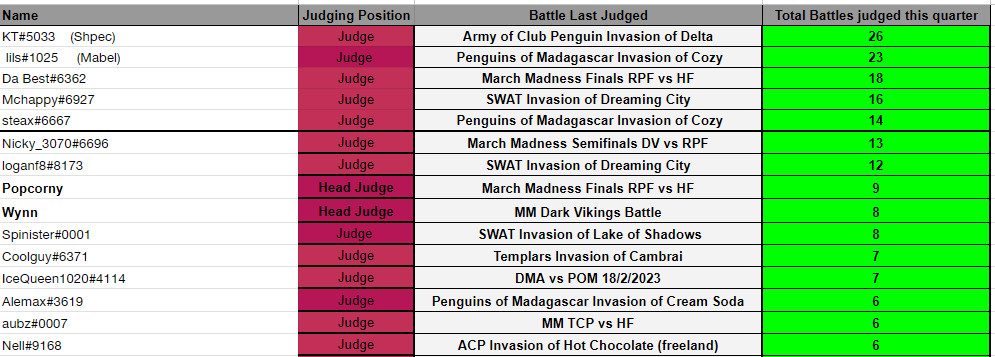
Who has judged the most in Q1 2023?
Based off of this, the Head Judges in my hypothetical would be:
- KT (Shpec)
- Mabel
- Da Best
- Mchappy
- Steax
I don’t want to comment really on whether they would be good or not or whether my criteria is even any good, however I thought it would be interesting to see what it could look like in a brief while.
Penguins of Madagascar vs Special Weapons and Tactics
I think the biggest issue this war suffered from was Three Tie Battles. They suck. Rather than a guideline issue as I believe it’s mainly posed as, I believe this is more a mentality issue. If you look hard enough, I think you can find a victor in every single room however it’s just having the mentality that you will find a winner rather than accepting what I believe to be the easy option and voting for a draw. This war was a particularly close one so it seemed judges had a struggle in determining winners in many instances. In an ideal world there would be no ties, as every room judges would be able to discern a winner from it.
In their treaty, they mention the guidelines. This is the seeming trend of the politics of the day with the guidelines being the big evil.
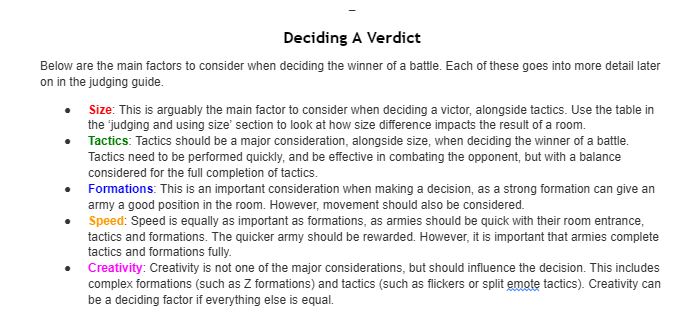
Deciding a Verdict in the current guidelines.
If we were to update the guidelines today, the very vast majority of this information would remain the same. That size table thing would probably be reworded however I don’t think any of the information regarding Tactics, Formations, Speed and Creativity is changing. Based off the above information and the further information that is provided, is it possible to be continuously running into ties in this war.
Interestingly, thirty six competitive rooms took place, where both armies showed and fought, during this war without including OT’s for those where three ties happened. A whooping fourteen ties occurred in those thirty six rooms leading to a tie percentage of 39%.

Ties in the POM vs SWAT War
I fail to believe that the above guidelines were the cause of this phenomenon taking place. I also don’t subscribe to the idea that the judges are that unaware of what the current guidelines are. As far as I’ve seen in all those judging gc’s I’ve reviewed and those I’ve been a part of over the years, I’ve rarely come across a judge who was so completely ignorant of the above rules. The vast majority of the judges who judge currently in CPAJ are known in the community, I’m very certain they know what does and doesn’t matter.
So to fix my perceived judging mentality issue, does the guidelines need to be revamped in order to be more specific? Will that solve the mentality issue of judges not being able to select in a winner in close circumstances? I’m not sure it does as the easy option will always be the easy option.
If we take the opinion that the guideline update will fix this mentality issue, the question has to be posed, what do we update in the guidelines? I think community wide the issue of BWBs is quite high on the issues the modern day playerbase has. So let’s try and fix it.


Notes on Big Word Bubbles from the current guidelines.
The only way I can really see to make it more specific is to start adding percentages to the equation. So what percentage of BWBs is acceptable, what is unacceptable? Would the consensus be that if an army has >40% BWBs that it would be detrimental, how detrimental? Can we expect the judges in a real time battle to be accurately tracking the percentage of BWBs that an army is using to determine whether it not they’re going over a certain threshold?
I think the problem in solving certain issues within the guidelines is to make it more formulaic, but it makes judging harder and less fun by making it more formulaic. So it begs the question, where is the line? One predominant reason the guidelines haven’t really been touched is due to the worry of this overarching formulaicness that would need to be implemented to try and solve certain issues.
A Quick Word on Training
With all the discussion recently surrounding the organisation I’d like to quickly comment on my thoughts with the current training. Essentially my opinion is that I’d be more open to a more extensive training programme if there was a wider pool of talent to select from. Right now everyone who is a well known community member and wants to be a judge is a judge and applicants for JiT are few and far between. With a potential guideline update and perhaps adding some form of written test, do I think judging standards will really improve? No not really. Maybe I’m ignorant on this subject as I’ve been around as long a I have but I just don’t see how these newer judges can be prepared for the real time and difficult experience of judging without just experiencing it for themselves.
Rebel Penguin Federation vs Army of Club Penguin March Madness Quarter Final
Quite recently, I had the job of reviewing the RPF vs ACP March Madness Quarter Final. Reviews usually are boring as well, you know you’re not going to overturn it as it takes a substantial lapse in judgment to really warrant an overturn and with the incessant reviews of the day just devaluing them, it’s extremely unlikely to see an overturn.
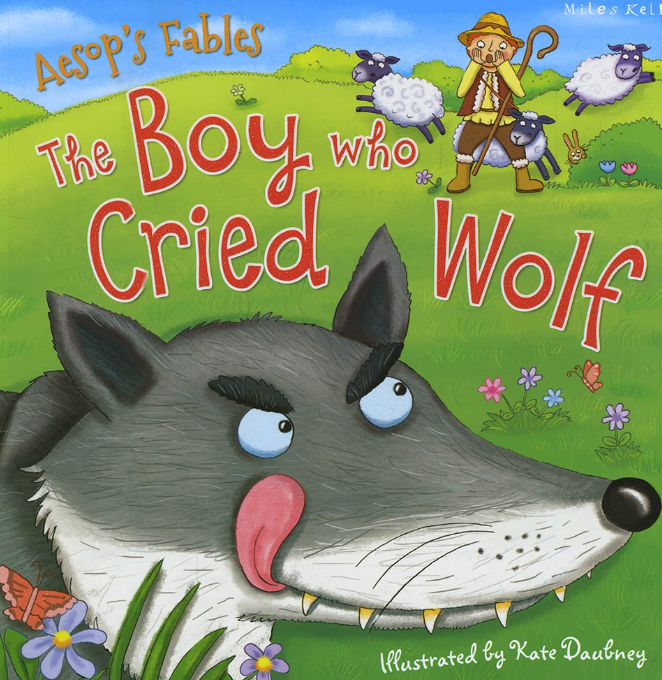
The way I see reviews is similar to the plot of The Boy Who Cried Wolf, people keep reviewing and perhaps the one times it’s worthy of an overturn, nobody believes you.
However this review I took seriously due to the magnitude of the battle and for context, the room in question was the Overtime Room and my full review which I will be discussing quite significantly for the rest of this piece can be found here.
For the purposes of this upcoming discussion, I’d like to outline the two terms I’ll be using on occasion.
Numerical Judging – Factors that are judged using numbers, for example Size, Tactical Speed, Troop:Tactic ratios
Optical Judging – Visual and more subjective judging elements, for example Covering and Formations
I am a firm believer that Numerical is more important than Optical however in recent times and this battle is quite an interesting one in the debate of the significance of each of the terms.
Size
Size is the most important factor in CPA Battles. Not everyone seems to think so as I’ve seen people discuss in CPA Main Chat that size shouldn’t be a factor which did quite amuse me but for all intensive purposes it is.
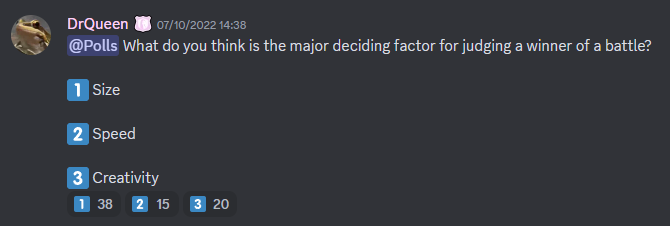
Taken from CPA Polls, it seems the general consensus is that Size is the most important factor to the community.
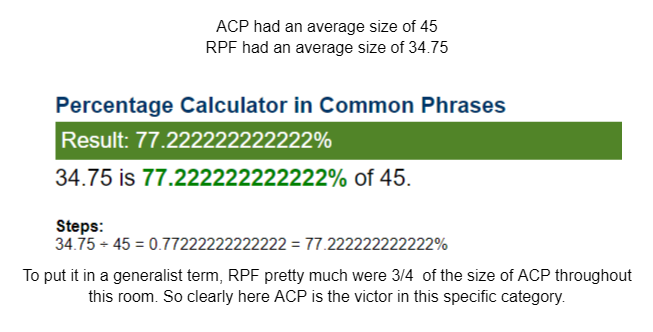
Size difference between ACP and RPF during the OT Room of the MM QF.
Numerically, ACP is larger than RPF and by a healthy margin, a 10 penguin advantage is nothing to be snuffed at and percentage wise they are 23% larger. So there we go we have a baseline percentage to compare other stats against, to see if it can overcome this.
Tactical Speed

Stats from the Tactical Speed of the MM QF.
We have established that the common opinion is that size is the most important factor and I am a believer that Tactical Speed is definitely an important factor as a believer in numerical judging. We can deduce from our stats that RPF were 13% faster than ACP during this room.
Tactical Variety
There are three elements of tactical variety.
- The balance between emotes and word tactics
- The balance between Creative Word Tactics and BWBs (labelled Generic Word Tactics in my review)
- The variety of which emotes are performed. Mainly discussed as normal emotes vs flicker emotes.
I should note how I am defining a balance, a balance in my eyes is a 50/50 split in both Emote and Word Tactics, again for Creative Word Tactics and BWBs (labelled Generic Word Tactics in my review).
Labelled in order of importance, these elements combine overall to create an overarching view of tactical variety. A criticism here could be that these elements are not listed in any guideline and are very much of my own judging style, however being able to judge such metrics accurately is only possible with a video and time to review properly. In real time this is hard to accurately track.

RPF had 30% Emote Tactics, whereas ACP had 42%, a slightly better balance for our first element.

RPF had a better balance of Creative Word Tactics, compared to ACP.
Of course here, a “Creative” word tactic is subjective, this statistic is of course open to interpretation and others may have it differently to myself. Our final element, the variety of which emotes are performed, really wasn’t a factor with one flicker being performed by ACP the whole room, RPF doing none.
Let’s get some numbers involved. For our first element, ACP had a 12% better balance than RPF did in this room. Whereas for our second element RPF had a 9% better balance for this particular metric. What we can infer here is that in terms of variety, both armies really had the match of each other and you wouldn’t give this metric much credence in determining the overall winner of the room.
Troop:Tactic Ratio
To be clear what this is, it is the amount of troops doing the tactics, compared to the amount of troops the army has in a room. If an army has ten troops and five are doing the tactics, they have a 50% troop:tactic ratio. I think of all the things to judge, this is the hardest and is for me the most interesting part of the Numerical vs Optical discussion.
In my review, I judge the Troop:Tactic ratio using photos of when both armies are doing an Emote and when both armies are doing a Word Tactic. Please feel free to view the google doc to look at the evidence taking.
Emote vs Emote the results were:
ACP = 62.8% RPF = 66.5%
Word Tactic vs Word Tactic the results were:
ACP = 53.1% RPF = 57.4%
What we can infer here is that RPF had a higher rate of their troops doing the tactics. Yet the interesting thing here is when we look at the percentages, RPF were only 4% better than ACP in both categories when we know from our previous stats the ACP are 23% bigger on average throughout the room. Of course these are only averages and must be taken as such, they are not completely accurate but overall can paint of picture of what likely was the case throughout the room. With the difference in percentages we can infer that even though RPF had more percentage of their troops doing the tactics, due to the size differential, ACP on average had more troops doing the tactics, giving ACP the numerical advantage.

ACP having a lower Troop:Tactic Ratio yet having more penguins doing the Tactic than RPF.
The secondary benefit of me doing that was to look at AFK’ing. So ACP had a lesser Troop:Tactic ratio and more troops, so did they have more AFK troops? Yes. I think optically here that’s played a big deal just because you’re automatically drawn to small subsections of troops not doing tactics, and with ACP having more troops and a lower Troop:Tactic ratio, coupled with a slower speed, they look more AFK which impacts the judging decision. What we discovered with this Troop:Tactic ratio checking that really apart from RPF were in that commanding A formation, ACP still had more troops doing tactics than RPF.

ACP have almost half their troops not doing the tactic yet still have the same amount as RPF.
I alluded earlier that Troop:Tactic to me is a numerical judging factor, however in real time, the Troop:Tactic judging factor actually is a lot more impactful optically. What I believe has occurred is that whilst ACP have a higher size and having on average, more troops doing the tactics than RPF, they’ve been disadvantaged by their size, as with more size comes more AFK’s, visually looking worse for them.
The question here has to be, is this wrong or right? Should ACP have essentially been disadvantaged by their size and even though they had more troops doing tactics on average they visually looked weaker? I don’t think they should be, the size is the most important factor and still there was only a 4% difference in Troop:Tactic ratio. What has happened and I cannot blame the judges in real time for this as everyone is guilty, I was certainly guilty the first time round watching the battle as I thought RPF looked better in this area before doing any calculations is that the optics has prevailed over the numeric.

2023 Judges
Formations
Long story short anyone who knows anything knows RPF will have the better forms in a room. In this optical inspection, RPF wins.
Bombs
Overall, I don’t think either army did very well here. Both armies did 5 word bombs and that’s pretty much it. It’s an area that someone could have capitalised on but there was no variety here, nothing about any of the bombs that was at all remarkable so not much else to say.
Covering
Before I really get into it there’ll probably be someone reading if anyone has done to this point that I’ve not really mentioned covering because I really don’t think it had any impact on this battle. ACP controlled the chatbar line for the majority of it with RPF doing well to counter that with a + Form and an A form that kept a good proportion of troops away from being covered by that chatbar line on most occasions. In a battle like this where both armies are maxing what they are and with the mass bubbles of the day, there’s not really a winner or loser here.
Conclusion
So let’s see what we have. We have the fact that ACP averaged 10.25 more troops and that RPF were only in the 77th percentile of ACP’s size. I think for a battle of this size and magnitude that’s a respectable size advantage and sets you in good stead. Numerically speaking this was the case but I think optically it wasn’t as noticeable as the 10.25 average makes it out to be. I think in the modern day judging different people have different judging opinions on whether numerical size or optical size is more important. I don’t think it’s as nuanced as just saying they have 13 more troops they automatically win, there should be some debate of how those 13 more troops are being used effectively but numerical size has traditionally been the main contributor so what do you do?
RPF have not won size wise, we figured that they didn’t have quite enough speed wise to even it out but were certainly quicker, tactical variety was a tight call but ultimately you couldn’t draw a victor from it and finally numerically speaking Troop:Tactic ratio did have an edge for RPF but overall ACP would have had more troops doing tactics on a regular basis. We’ve also established neither army really had a massive edge in terms of covering and bombs. With this information I’d think the majority of people would call this room an ACP victory in a close battle but with size and more troops doing tactics, you’d give them the edge.
However, our old friend optical judging is back in town and he’s thrown it into chaos unexpectedly. He’s seen RPF having better formations and that ACP has more AFK’s amongst the ranks and has thrown the victory towards RPF.

I think this piece of evidence is so crucial to understanding why RPF won. ACP have half the army not doing the tactic, leading to concerns they’re dead, yet in real time it would be tough to analyse that ACP even though they have a lot of AFK’s, they actually have the same amount of troops doing the tactic.
The Optics has prevailed over the Numeric side of judging in this and I’d like to once more stress it’s not anyone’s fault that this has happened.
Final Thoughts
The biggest issue for me facing judging is this Numerical vs Optical judging conundrum. What has happened as evidenced above is that Optical, subjective judging has taken the lead against Numerical, objective judging. The reason this is, is because optical judging is a lot easier to discern in real time against numerical judging. Due to the subjective nature of this, judging results have just gone a bit wild with some judges valuing some things way more over others. You’d be right to again say, get some guidelines in place to stop this happening but how do you make the subjective objective without creating a formula that would be tough to follow in real time. It’s a very tough balancing act.
For me, I think judges need to go into the battles with a mentality that all rooms will have a winner and loser and to try and gather as much objective and justifiable data that can create an outcome with the vast majority being that there is a winner and loser. This is hard in real time, I struggle with it and this difficulty puts many off judging leading to a lack of those willing to do the job.
amazing post!
[…] video will go into all the events of this week featuring: a multilogging scandal, a captivating Head Judge editorial, a proposition to fix the board, and yet another Top Ten reshuffling, alongside other subjects. A […]
[…] “most hated job in CPA.” Another editorial followed shortly thereafter, detailing the thoughts of a Head Judge. With this in mind, Time Capsule has set out to interview the four current Head Judges. We aim to […]